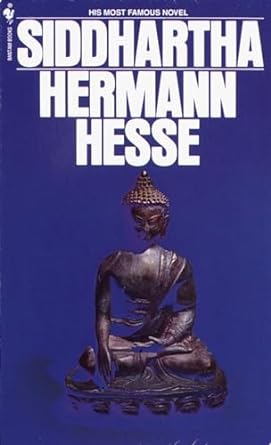“Siddhartha” is one of my favorite books. One of the books i added to my collection as a 12 year old. It reminds me greatly of “The Alchemist” by one of my other favorite authors, Paulo Coelho. Siddhartha is a novel written by German-Swiss author Hermann Hesse, first published in 1922. The novel tells the story of Siddhartha, a young man who embarks on a spiritual journey of self-discovery in ancient India.

At the beginning of the novel, Siddhartha is a Brahmin, or Hindu priest, who is dissatisfied with the formalism and rigidity of his religious tradition. He feels that he has not yet found the answers he is looking for and decides to leave his home and join a group of ascetics who practice extreme self-denial and meditation. Siddhartha quickly becomes a model student of this way of life, but he ultimately finds that it fails to bring him the enlightenment he seeks.
Siddhartha then leaves the ascetics and eventually meets the Buddha, who teaches him the concept of the Middle Way, a path of moderation between the extremes of self-indulgence and self-denial. Although Siddhartha admires the Buddha’s teachings, he realizes that he must find his own path to enlightenment.
at the Feet of the Buddha
In the novel “Siddhartha” by Hermann Hesse, Siddhartha and his best friend , Govinda have a conversation about Siddhartha’s decision not to become a follower of the Buddha, despite being deeply moved by his teachings.
Siddhartha explains to Govinda that he respects and admires the Buddha’s wisdom and enlightenment but chooses not to become a disciple. He believes that true wisdom cannot be taught or passed down; it must be personally experienced. Siddhartha expresses his belief that each person must find their own path to enlightenment and understanding.
Govinda, on the other hand, is drawn to the Buddha’s teachings and decides to become a follower. He believes in the power of learning from a master and following a set of teachings to attain enlightenment.
The conversation between Siddhartha and Govinda reflects the central theme of individual spiritual exploration and the idea that enlightenment is a personal journey that cannot be fully conveyed through teachings alone.
Vasudeva,…. the Mystical FerryMan and the River.
Siddhartha continues on his journey. His journey is interrupted by the mystical presence of Vasudeva, the ferryman. Vasudeva invites Siddhartha to stay with him and learn the secrets of the river. Siddhartha, initially reluctant, agrees. The river becomes a metaphor for time, change, and the interconnectedness of all things.
As Siddhartha spends time by the river, he learns to listen to its flow, understanding the unity of all voices within it. The river teaches him about the cyclical nature of life, the eternal present moment, and the harmony that exists in the universe.
One crucial moment occurs when Siddhartha, while listening to the river, realizes that everything is connected, and he experiences a profound sense of inner peace. The river becomes a source of enlightenment for Siddhartha, leading him to a deep understanding of the oneness of existence.
This transformative experience by the river marks a turning point in Siddhartha’s spiritual journey, setting him on the path to true enlightenment and self-realization.
Success….. the Pleasures of the World
The next morning, Siddhartha continues on his journey, encountering a variety of people and situations, including a courtesan named Kamala, with whom he has a child.
The protagonist, Siddhartha, a monk who looks like a beggar, has come to the city and falls in love with a famous courtesan. He attempts to court her, and she asks, “What do you have?” A well-known merchant similarly asks, “What can you give that you have learned?” His answer is the same in both cases, so I’ve included the latter story below.
Merchant: “. . . If you are without possessions, how can you give?”
Siddhartha: “Everyone gives what he has. The soldier gives strength, the merchant goods, the teacher instruction, the farmer rice, the fisherman fish.”
Merchant: “Very well, and what can you give? What have you learned that you can give?”
Siddhartha: “I can think, I can wait, I can fast.”
Merchant: “Is that all?”
Siddhartha: “I think that is all.”
Merchant: “And of what use are they? For example, fasting, what good is that?”
Siddhartha: “It is of great value, sir. If a man has nothing to eat, fasting is the most intelligent thing he can do. If, for instance, Siddhartha had not learned to fast, he would have had to seek some kind of work today, either with you, or elsewhere, for hunger would have driven him. But, as it is, Siddhartha can wait calmly. He is not impatient, he is not in need, he can ward off hunger for a long time and laugh at it. ”
I think of Siddhartha’s answers often and in the following terms:
“I can think” → Having good rules for decision-making, and having good questions you can ask yourself and others.
“I can wait” → Being able to plan long-term, play the long game, and not misallocate your resources.
“I can fast” → Being able to withstand difficulties and disaster. Training yourself to be uncommonly resilient and have a high pain tolerance
Siddhartha becomes a successful merchant, wins the heart of courtesan named Kamala, with whom (unbeknownst to him) he has a child… he becomes a wealthy, successful Merchant. Everything a man wishes for and calls success. Yet he is depressed, even considers suicide. He eventually realizes that he has spent too much time pursuing worldly pleasures, he is has gained the world, but lost his peace.
“I have had to experience so much stupidity, so many vices, so much error, so much nausea, disillusionment and sorrow, just in order to become a child again and begin anew. I had to experience despair, I had to sink to the greatest mental depths, to thoughts of suicide, in order to experience grace.”
This quote captures Siddhartha’s realization that true fulfillment and renewal come not from material success but from transcending worldly struggles and finding inner peace. He decides to abandon his material possessions and live a life of simplicity and contemplation.
He returns to the river. He becomes a ferryman, working on a river, and finds peace and contentment in his new way of life.
Years later, Siddhartha’s son comes to live with him and becomes rebellious and unhappy. His son does not think being a FerryMan is all that!! Siddhartha wakes to find that his son has rub away. Siddhartha goes searching for him.
As he searches he sees his old friend Govinda on other side of river. Siddhartha’s has a conversation with Govinda about his son, who has become rebellious and restless. Siddhartha, now a wise and enlightened ferryman, …. understands the importance of allowing his son to find his own path.
Siddhartha shares with Govinda that his son, like any individual, must embark on his unique journey of self-discovery. Siddhartha expresses that he cannot impose his wisdom or experiences on his son; everyone must seek their own understanding of life.
The conversation reflects Siddhartha’s evolved perspective on parenting and mentorship. Instead of enforcing his beliefs, Siddhartha chooses to let his son make his own choices and face the consequences. This decision signifies Siddhartha’s acceptance of the individual’s autonomy in their quest for meaning and enlightenment.
Throughout the novel, Hesse explores themes of spirituality, self-discovery, and the search for meaning in life. Siddhartha’s journey represents a universal quest for personal growth and understanding, and his struggles and triumphs serve as a source of inspiration for readers. The novel’s timeless message and enduring popularity have made it a classic of spiritual and philosophical literature.
Throughout the novel, Hesse explores themes of spirituality, self-discovery, and the search for meaning in life. The novel’s emphasis on individuality and personal experience has made it a popular and influential work in the realm of spiritual and philosophical literature.
“Siddhartha” has been translated into dozens of languages and has inspired countless individuals to embark on their own journeys of self-discovery and spiritual growth. The novel’s enduring popularity is a testament to its universal themes and timeless message.
